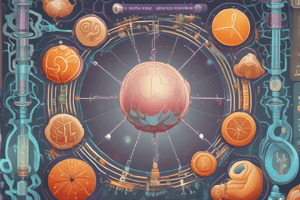Podcast
Questions and Answers
What is glycogen?
What is glycogen?
A polysaccharide found in animals.
Glucose + glucose ---> _________ by __________.
Glucose + glucose ---> _________ by __________.
maltose + water, dehydration synthesis.
Which of these is a source of lactose?
Which of these is a source of lactose?
- Bread
- Sugar
- Milk (correct)
- Cheese
Which of these is a polysaccharide?
Which of these is a polysaccharide?
What is the most abundant organic compound on Earth?
What is the most abundant organic compound on Earth?
What is not a lipid?
What is not a lipid?
What is rich in unsaturated fats?
What is rich in unsaturated fats?
What is a function of cholesterol that does not harm health?
What is a function of cholesterol that does not harm health?
Proteins are polymers of?
Proteins are polymers of?
What type of bond joins the monomers in a protein's primary structure?
What type of bond joins the monomers in a protein's primary structure?
The secondary structure of a protein results from?
The secondary structure of a protein results from?
Tertiary structure is not directly dependent on?
Tertiary structure is not directly dependent on?
A protein's function is largely determined by its?
A protein's function is largely determined by its?
In the analogy of beads on a string, what do the beads represent?
In the analogy of beads on a string, what do the beads represent?
At what level of protein structure does a protein's alpha helices and beta sheets fold together?
At what level of protein structure does a protein's alpha helices and beta sheets fold together?
What happens to the shape and function of a protein if one amino acid is replaced?
What happens to the shape and function of a protein if one amino acid is replaced?
What level of protein structure describes how polypeptides are joined in large proteins?
What level of protein structure describes how polypeptides are joined in large proteins?
Which of the following is the largest unit of DNA organization?
Which of the following is the largest unit of DNA organization?
What are the components of a nucleotide?
What are the components of a nucleotide?
How many polynucleotides are found in one molecule of DNA?
How many polynucleotides are found in one molecule of DNA?
Which of the following makes up the backbone of a polynucleotide strand?
Which of the following makes up the backbone of a polynucleotide strand?
A page is to a book as a ? is to the genome.
A page is to a book as a ? is to the genome.
What does a relative risk (RR) of 1 mean?
What does a relative risk (RR) of 1 mean?
What does an RR greater than 1 indicate?
What does an RR greater than 1 indicate?
What does an RR less than 1 indicate?
What does an RR less than 1 indicate?
What is the RR for monounsaturated fat?
What is the RR for monounsaturated fat?
What is the RR for polyunsaturated fat?
What is the RR for polyunsaturated fat?
What is the RR for saturated fat?
What is the RR for saturated fat?
What is the RR of trans fat?
What is the RR of trans fat?
For each increase of 2% in energy from trans fats, what is the increased risk of heart disease?
For each increase of 2% in energy from trans fats, what is the increased risk of heart disease?
Flashcards are hidden until you start studying
Study Notes
Carbohydrates
- Glycogen is a polysaccharide that serves as energy storage in animals.
- Two glucose molecules can combine to form maltose and water through dehydration synthesis.
- Lactose, the sugar in milk, is derived from dairy products.
- Cellulose is a prominent polysaccharide composed of numerous monomers and is the most abundant organic compound on Earth.
Lipids
- Olive oil is notably rich in unsaturated fats, typical of many plant oils.
- Cholesterol plays a beneficial role as a component of animal cell membranes but can be harmful in excess.
Proteins
- Proteins are polymers formed from amino acids linked by peptide bonds.
- The secondary structure of proteins is maintained by hydrogen bonds, while the primary structure involves peptide bonds.
- A protein’s function is primarily determined by its shape; alterations in amino acids may impact function based on the specific role of the amino acid changed.
- Large proteins like DNA polymerase and hemoglobin consist of multiple polypeptides, characterized by their quaternary structure.
Nucleotides & DNA
- Nucleotides consist of a sugar, phosphate, and base, forming the building blocks of DNA.
- A DNA molecule contains two polynucleotide strands with a sugar-phosphate backbone.
- The genome represents the largest unit of DNA organization, with genes serving as the pages of a book.
Health & Risk Factors
- Relative risk (RR) of 1 indicates no change in heart disease risk related to carbohydrate intake.
- An RR above 1 denotes a higher risk of heart disease compared to equivalent carbohydrate intake, while an RR below 1 shows a reduced risk.
- Monounsaturated fats present an RR of 0.81, suggesting a protective effect on heart disease risk when consumption increases.
- Polyunsaturated fats exhibit the lowest RR, indicating they are most beneficial for heart health.
- Saturated fats show an RR of 1.17, indicating a 17% increase in heart disease risk with a 5% rise in energy intake.
- Trans fats carry the highest RR among fats, where a 2% increase in energy from trans fats correlates with a 93% increased risk of heart disease.
Studying That Suits You
Use AI to generate personalized quizzes and flashcards to suit your learning preferences.




